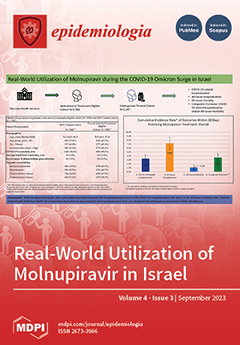Open AccessArticle
Outbreak Investigation of Typhoid Fever in the District of Gabes, South of Tunisia
by
Aicha Hechaichi, Hind Bouguerra, Hajer Letaief, Mouna Safer, Lamia Missaoui, Amal Cherif, Saffar Farah, Houcine Jabrane, Taoufik Atawa, Hamdi Yahia, Hayet Hamdouni, Khadija Zitoun, Karim Chahed, Ramzi Laamouri, Jaber Daaboub, Mohamed Rabhi, Afif Ben Salah, Mohamed Kouni Chahed and Nissaf Bouafif Ben Alaya
Cited by 1 | Viewed by 2693
Abstract
Typhoid fever is a significant public health concern in many parts of the world, particularly in developing countries with poor sanitation and hygiene conditions. In July 2016, an outbreak of typhoid fever occurred in Ghannouche, located in the south of Tunisia. This paper
[...] Read more.
Typhoid fever is a significant public health concern in many parts of the world, particularly in developing countries with poor sanitation and hygiene conditions. In July 2016, an outbreak of typhoid fever occurred in Ghannouche, located in the south of Tunisia. This paper reports the results of a field investigation undertaken to identify possible transmission pathways and risk factors in order to propose control and preventive measures. A retrospective cohort study including a passive and active case finding, as well as an environmental and bacteriological investigation was conducted from July to September 2016. A case was defined as a person residing or having stayed in Ghannouche and having presented from the beginning of June clinical signs suggestive of typhoid fever, with, for a confirmed case, laboratory isolation of S.Tyhi, and for a probable case, an epidemiological link with a confirmed case. Attack rates were determined, and risk ratios were estimated with respect to exposures. Unadjusted and adjusted odds ratios were estimated using binary logistic regression. Among the 628 subjects investigated, 102 cases of typhoid fever were identified (74 confirmed and 28 probable) with an overall attack rate of 16.24%. Over 56% of cases were male and those under 10 years old were most affected (38.2%% of cases) with a median age of 12 years (interquartile range 5 to 25 years). The main clinical signs were fever (95%) and diarrhea (57%). Young age (adjusted OR = 0.95 and 95% CI = 0.93–0.97), low level of education (adjusted OR = 4.76 and 95% CI = 1.34–16.81), and the habitat type Arab or rudimentary house (adjusted OR = 4.93 and 95% CI = 2.61–8.27) were the socio-demographic factors independently associated with typhoid fever. Typhoid fever was found to be associated with drinking softened water (adjusted OR = 2.64 and 95% CI = 1.16–4.82), eating raw fruit and vegetables from family gardens (adjusted OR = 6.13 and 95% CI = 3.66–11.06), and using uncontrolled waste disposal (adjusted OR = 3.52 and 95% CI = 2.03–6.94). A total of 110 drinking water samples were analyzed; out of the 38 samples of softened water, 12 were non-compliant and 5 were positive for
Salmonella. The screening activity identified two asymptomatic carriers, one of whom was a softened water seller. We concluded that drinking softened water from informal or unauthorized sale units, consuming fruit and vegetables from family gardens, uncontrolled dumping of household waste, and poor socio-economic conditions increase the risk of typhoid fever in this region. Many recommendations were implemented to stop this outbreak and to prevent further episodes.
Full article
►▼
Show Figures





